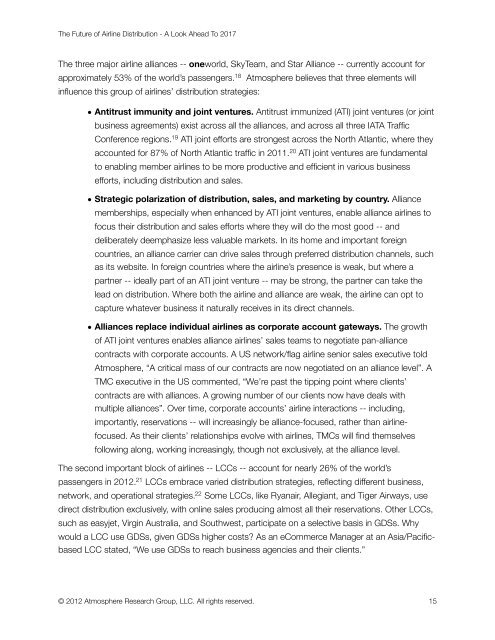The Future Of Airline Distribution - IATA
The Future Of Airline Distribution - IATA
The Future Of Airline Distribution - IATA
You also want an ePaper? Increase the reach of your titles
YUMPU automatically turns print PDFs into web optimized ePapers that Google loves.
<strong>The</strong> <strong>Future</strong> of <strong>Airline</strong> <strong>Distribution</strong> - A Look Ahead To 2017<br />
<strong>The</strong> three major airline alliances -- oneworld, SkyTeam, and Star Alliance -- currently account for<br />
approximately 53% of the world’s passengers. 18 Atmosphere believes that three elements will<br />
influence this group of airlines’ distribution strategies:<br />
• Antitrust immunity and joint ventures. Antitrust immunized (ATI) joint ventures (or joint<br />
business agreements) exist across all the alliances, and across all three <strong>IATA</strong> Traffic<br />
Conference regions. 19 ATI joint efforts are strongest across the North Atlantic, where they<br />
accounted for 87% of North Atlantic traffic in 2011. 20 ATI joint ventures are fundamental<br />
to enabling member airlines to be more productive and efficient in various business<br />
efforts, including distribution and sales.<br />
• Strategic polarization of distribution, sales, and marketing by country. Alliance<br />
memberships, especially when enhanced by ATI joint ventures, enable alliance airlines to<br />
focus their distribution and sales efforts where they will do the most good -- and<br />
deliberately deemphasize less valuable markets. In its home and important foreign<br />
countries, an alliance carrier can drive sales through preferred distribution channels, such<br />
as its website. In foreign countries where the airline’s presence is weak, but where a<br />
partner -- ideally part of an ATI joint venture -- may be strong, the partner can take the<br />
lead on distribution. Where both the airline and alliance are weak, the airline can opt to<br />
capture whatever business it naturally receives in its direct channels.<br />
• Alliances replace individual airlines as corporate account gateways. <strong>The</strong> growth<br />
of ATI joint ventures enables alliance airlines’ sales teams to negotiate pan-alliance<br />
contracts with corporate accounts. A US network/flag airline senior sales executive told<br />
Atmosphere, “A critical mass of our contracts are now negotiated on an alliance level”. A<br />
TMC executive in the US commented, “We’re past the tipping point where clients’<br />
contracts are with alliances. A growing number of our clients now have deals with<br />
multiple alliances”. Over time, corporate accounts’ airline interactions -- including,<br />
importantly, reservations -- will increasingly be alliance-focused, rather than airline-<br />
focused. As their clients’ relationships evolve with airlines, TMCs will find themselves<br />
following along, working increasingly, though not exclusively, at the alliance level.<br />
<strong>The</strong> second important block of airlines -- LCCs -- account for nearly 26% of the world’s<br />
passengers in 2012. 21 LCCs embrace varied distribution strategies, reflecting different business,<br />
network, and operational strategies. 22 Some LCCs, like Ryanair, Allegiant, and Tiger Airways, use<br />
direct distribution exclusively, with online sales producing almost all their reservations. Other LCCs,<br />
such as easyjet, Virgin Australia, and Southwest, participate on a selective basis in GDSs. Why<br />
would a LCC use GDSs, given GDSs higher costs? As an eCommerce Manager at an Asia/Pacific-<br />
based LCC stated, “We use GDSs to reach business agencies and their clients.”<br />
© 2012 Atmosphere Research Group, LLC. All rights reserved. 15

















